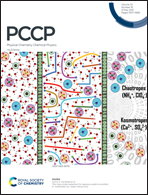Bond-forming and electron-transfer reactivity between Ar2+ and N2†
Abstract
Collisions between Ar2+ and N2 have been studied using a coincidence technique at a centre-of-mass (CM) collision energy of 5.1 eV. Four reaction channels generating pairs of monocations are observed: Ar+ + N2+, Ar+ + N+, ArN+ + N+ and N+ + N+. The formation of Ar+ + N2+ is the most intense channel, displaying forward scattering but with a marked tail to higher scattering angles. This scattering, and other dynamics data, is indicative of direct electron transfer competing with a ‘sticky’ collision between the Ar2+ and N2 reactants. Here Ar+ is generated in its ground (2P) state and N2+ is primarily in the low vibrational levels of the C2Σu+ state. A minor channel involving the initial population of higher energy N2+ states, lying above the dissociation asymptote to N+ + N, which fluoresce to stable states of N2+ is also identified. The formation of Ar+ + N+ by dissociative single electron transfer again reveals the involvement of two different pathways for the initial electron transfer (direct or complexation). This reaction pathway predominantly involves excited states of Ar2+ (1D and 1S) populating N2+* in its dissociative C2Σu+, 22Πg and D2Πg states. Formation of ArN+ + N+ proceeds via a direct mechanism. The ArN+ is formed, with significant vibrational excitation, in its ground (X3Σ−) state. Formation of N+ + N+ is also observed as a consequence of double electron transfer forming N22+. The exoergicity of the subsequent N22+ dissociation reveals the population of the A1Πu and D3Πg dication states.

- This article is part of the themed collection: 2021 PCCP HOT Articles


 Please wait while we load your content...
Please wait while we load your content...